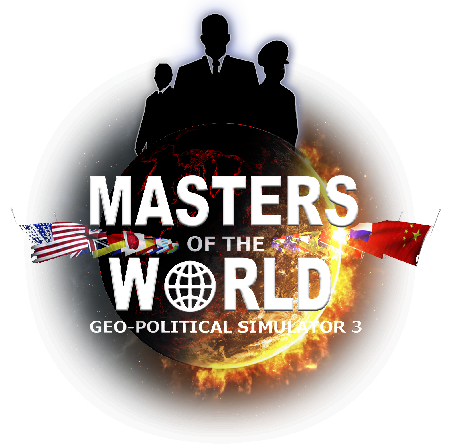


Articles on different versions of Geo-Political Simulator



SIMULATION
The game includes a substantial number of data and various items of information, drawn from the main world data banks, in order to assess the new situation of the planet at all times. Indicated below are the details of the parameters taken into consideration. The simulations are classified into different categories.3D Worldmap
This map identifies a large number of points and places:- mountain reliefs, detailed vegetation, cultural zones, different types of forest (broadleaf, pine, rainforests), savannas, rivers, and urban areas
- all state borders and territorial waters
- the division of countries into over 1,200 administrative
- over 7000 towns
- over 1,000 military bases (land, air, naval, satellite launch
- over 300 nuclear plants, offshore stations, wind farms on
- the 124 most important ports and 150 most important airports, high speed rail networks
- gas and oil wells with the major gas and oil pipelines
- over 130 mountain peaks and volcanoes
- over 100 historical and cultural locations
The weather engine
This engine uses the planet’s seasonal maps and temperature projections for the 21st century to simulate the weather map.
The environment and health engine
Coupled with the weather, this engine can simulate many types of disasters:
- global warming
- droughts and heat waves
- floods
- cold snaps
- volcanic eruptions (locations and risk assessment of major volcanoes)
- earthquakes and tsunamis (locations and risk assessment of major fault lines)
- hurricanes and tornadoes (path locations and risk assessment of major hurricanes)
- epidemics (considers the triggering and aggravating factors for cholera, the plague, and the Ebola virus)
- nuclear accidents (location and age of nuclear plants in the world)
- forest fires (location of risk areas)
- oil spills (location of risk areas)
Nations and their variables
230 countries and territories recognized by the UN are managed in the game, with about 175 playable nations. Each sovereign country includes over 600 variables in various subject areas, namely:
- Geography and climate: surface area, climate type, precipitation, major natural risks, forest area...
- Demographics: age pyramid contraception, life expectancy, migration flows...
- Economy: GDP, income / capita, unemployment, growth, inflation, HDI...
- Economic activities: production and consumption for over 130 activity sectors including agriculture (sale of livestock, fruits and vegetables, beverages, grains), industry (various minerals, processing industries, chemistry, automobile production...), and the service sector (telecommunication, transportation, advertising, record industry...).
- Energy: distribution and reserves of various energy sources (oil, gas, nuclear, hydroelectricity, new energy sources, etc.)
- Commerce: major partners, balance of trade, tourism...
- Budget: size and spending on various state budget items, state debt, rating with rating agencies
- Taxation: list of numerous taxes and duties (VAT, bracketed income tax, tax on the wealthy, fuel taxes, taxes on alcohol...)
- Money: interest rate, stock markets, currencies...
- Social / Labor / Health: minimum salaries, family benefits, medical reimbursement, basic old age pension, unemployment benefits, working time, housing allowances, etc..
- Society: regulations on contraception, abortion, same-sex marriage, same-sex parent adoption, physician-assisted suicide, prostitution, marijuana consumption...
- Education: illiteracy, staffing and salaries, length of school vacations, level of research...
- Constitution: type of regime, terms of office, election functioning, powers of Parliament...
- Politics: party in power, complete list of political parties and their ideologies, formation of a Parliament, positions on major international themes, membership with major international organizations...
- Police / Justice: crime rate, size and power of police forces and intelligence services, prisons, death penalty, traffic safety laws, etc.
- Immigration: migration rate, return assistance, foreign communities
- Terrorism: list of terrorist groups and assessment of their power
- Sects: list of different sects with evaluations of their size
- Army: size, weapon details, nuclear power, weapons manufacturing, military service...
- Religion: distribution and roles of different congregations
- Environment: Co2 emissions, Kyoto protocol, details on the various modes of transportation...
- Culture: national holiday, major cultural festivals, international museums, film, setting up the internet...
- Sports: results and rankings for major sporting events, level assessment in each discipline
The character database
This database includes over 300 figures for each country, i.e. over 50,000 characters in the world, with very diverse functions: politicians, unionists, association leaders, religious figures, military figures, intellectuals, journalists, scientists, athletes, people close to the head of state...
All characters are represented with 3D faces and express themselves orally during meetings. The game includes a total of over 8 hours of dialog.
Character names reflect the linguistic roots of different countries.
The artificial intelligence algorithms determine the characters’ reactions and initiatives.
Each character has a certain number of variables (age, health, personality, competence, ambition, political affiliation, hobbies, etc.) that help establish a sort of table of opinions on the different subjects in the game. These opinions are then compared with players’ actions and changes in the world. Their behaviors are determined based on the character’s popularity and level of influence.
International organizations
These organizations intervene throughout the game. The game includes over 50 organizations, including the UN and its various branches (IMF, World Bank), major organizations (NATO, G8, OPEC, BRICS, etc.), economic organizations (European Union, CIS, Mercosur, NAFTA, the Arab League, OAU, etc.), major NGOs (international aid, human rights, environmental, alter-globalization, etc.).
Foundations for economic and scientific discoveries
Over 150 economic sectors are featured along with their production and consumption rules (costs, raw materials, transport costs, workforce qualification, productivity...).
Also included are over 100 scientific discoveries and technological advances imagined for the next 50 years to come (aids vaccine, anti-sleep molecule digital paper, optical textiles, nanorobots, holographic TV...).
The dialog and article database
There are over 13,000 messages, press articles, and reactions to characters and organizations.
The game also includes eight hours of recorded dialogs.
The historical base
Major upcoming events are part of this database: organization meetings, election dates for each country, Olympic Game dates, major cultural events, religious holidays...





















